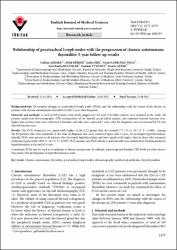Relationship of paratracheal lymph nodes with the progression of chronic autoimmune thyroiditis: 5-year follow-up results

View/
Date
2017Author
Akbaba, GülhanBerker, Dilek
Işık, Serhat
İmga, Narin Nasıroğlu
Küçükler, Ferit Kerim
Tütüncü, Yasemin
Güler, Serdar
Metadata
Show full item recordAbstract
Background/aim: To examine changes in paratracheal lymph nodes (PLNs) and the relationship with the course of the disease in patients with chronic autoimmune thyroiditis (CAT) 5 years after diagnosis. Materials and methods: A total of 169 patients with newly diagnosed CAT and 53 healthy subjects were included in the study. All patients underwent ultrasonographic (US) examinations of the thyroid, paratracheal regions, and examined thyroid function tests. Eighty-four patients who were euthyroid at baseline and who were contacted 5 years after the diagnosis were reevaluated by US and thyroid function tests. Results: The PLNs frequency was significantly higher in the CAT group than the controls (75.1 % vs. 30.1 %, P < 0.001). Among the 84 patients who were euthyroid at the time of diagnosis and were contacted again after 5 years, 15 developed hypothyroidism. Initially, PLNs were present in all patients who developed hypothyroidism and were significantly higher than in those who remained euthyroid (respectively 100% vs. 68.7%, P = 0.009). PLN presence and PLN volume in patients who were euthyroid at baseline predicted hypothyroidism at the end of 5 years. Conclusion: PLNs may be used as an indicator of disease progression. In addition, patient age and baseline TSH levels are other factors that predict the development of hypothyroidism in time.

















